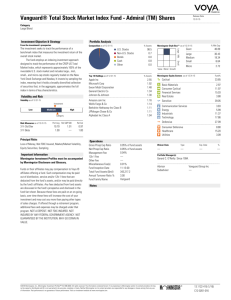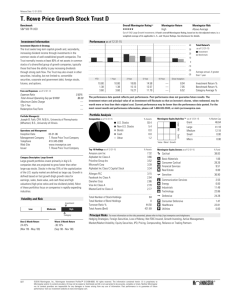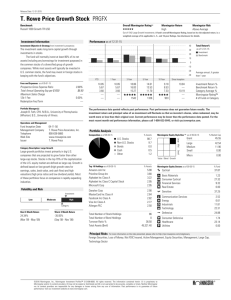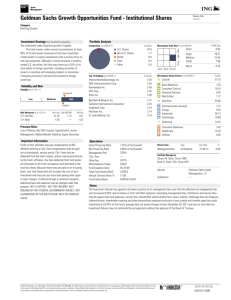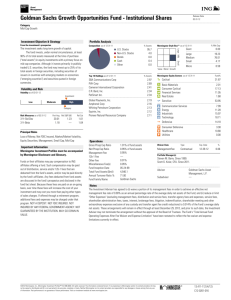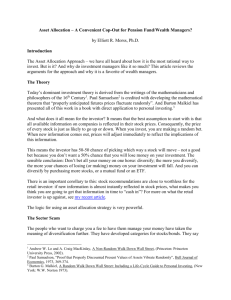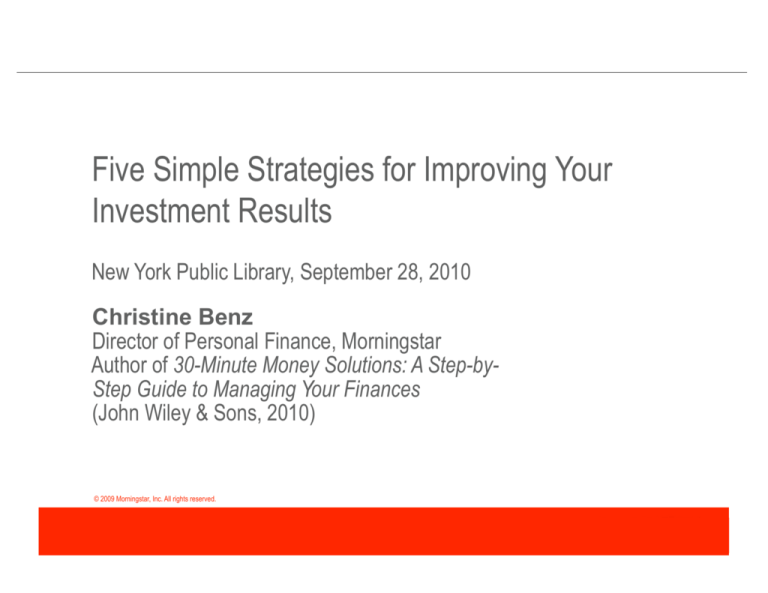
Five Simple Strategies for Improving Your
Investment Results
New York Public Library, September 28, 2010
Christine Benz
Director of Personal Finance, Morningstar
Author of 30-Minute Money Solutions: A Step-byStep Guide to Managing Your Finances
(John Wiley & Sons, 2010)
© 2009 Morningstar, Inc. All rights reserved.
<#>
Five Simple Strategies for Improving Your Investing Results
•
•
•
•
•
Simple Strategy #1: Focus on what you can control, tune out what
you can’t.
Simple Strategy #2: Find your own true north.
Simple Strategy #3: Use simple but effective building blocks.
Simple Strategy #4: Cheap out.
Simple Strategy #5: Put it on autopilot.
Simple Strategy #1: Focus on what you can control/
predict, tune out what you can’t.
In the category of what you can’t control/predict:
© 2009 Morningstar, Inc. All rights reserved.
<#>
3
Simple Strategy #1: Focus on what you can control/
predict, tune out what you can’t.
In the category of what you can’t control/predict:
• The direction of the economy
• The direction of interest rates
• The direction of the dollar (or euro, or yen..)
• The rate of inflation
• What stocks will return in the future
• What bonds will return in the future
© 2009 Morningstar, Inc. All rights reserved.
<#>
4
Simple Strategy #1: Focus on what you can control/
predict, tune out what you can’t.
So just what can you control?
© 2009 Morningstar, Inc. All rights reserved.
<#>
5
Simple Strategy #1: Focus on what you can control/
predict, tune out what you can’t.
So just what can you control?
• Your savings rate (doh!)
• Your stock/bond/cash mix
• The quality of investments that you choose
• The total investment-related costs you pay (including tax costs)
• Your own emotions
© 2009 Morningstar, Inc. All rights reserved.
<#>
6
Simple Strategy #2: Find your own true north.
•
•
•
Proper fund/stock/bond selection matters, but two other factors have
a bigger hand in whether you reach your goals: how much you save
and how you’ve split your money among stocks, bonds, and cash.
Two strategies for asset allocation: tactical (aka market-timing) and
strategic (aka buy and hold).
Tactical would be ideal, but there’s one problem: It doesn’t work
consistently.
© 2009 Morningstar, Inc. All rights reserved.
<#>
7
Dangers of Market Timing
Hypothetical value of $1 invested from 1988–2007
$10
$9.33
8
6
4
$2.36
2
0
Stocks
© 2009 Morningstar, Inc. All rights reserved.
<#>
Stocks minus best 18 months
$2.41
Treasury bills
A Starting Point for Strategic Asset Allocation:
Morningstar Lifetime Allocation Indexes
Retiring in 2010: 50% bond,
11% foreign stock, 33% U.S.
stock, 6% commodities
Retiring in 2020: 32% bond,
18% foreign stock, 45% U.S.
stock, 5% commodities
Retiring in 2030: 14% bond,
26% foreign stock, 55% U.S.
stock, 5% commodities
© 2009 Morningstar, Inc. All rights reserved.
<#>
9
A Starting Point for Strategic Asset Allocation:
Morningstar Lifetime Allocation Indexes
Retiring in 2040: 8% bond, 31%
foreign stock, 57% U.S. stock, 4%
commodities
Retiring in 2050: 7% bond, 34%
foreign stock, 55% U.S. stock, 4%
commodities
© 2009 Morningstar, Inc. All rights reserved.
<#>
10
Tailor your stock/bond/cash mix to suit your personal
circumstances. Factor in:
•
•
•
•
•
•
Your own human capital (Are you a stock or a bond?)
Longevity: Does it run in your family? (If so, more stocks)
Other assets/sources of income during retirement, such as a pension
(if so, more stocks)
How much you’ve saved (if the answer is “not much,” consider
adding more stocks, but don’t go overboard)
Risk capacity (if low, fewer stocks)
Desire to leave something for children/grandchildren (if so, more
stocks)
11
Check up on where you are now, then compare that to your target
allocations.
Use the following tools to give your current assets a checkup:
•
•
Use Morningstar Instant X-Ray (free tool) to determine your
portfolio’s asset allocation and style-box positioning. Save your
portfolio on Morningstar.com for ongoing tracking purposes. (X-Ray
is located on Tools cover page of Morningstar.com.)
Check up on whether you’re on track to meet your retirement goals
using T. Rowe Price’s free Retirement Income Calculator:
http://www3.troweprice.com/ric/ric/public/ric.do or the Retirement
Calculator on Morningstar Investment Research Center.
12
Simple Strategy #3: Use simple but effective building
blocks.
•
•
•
•
•
•
Don’t assume fancy/complicated strategies are better than more
straightforward ones.
Fewer, well-diversified investments can get the job done just as well.
You’ll also have fewer moving parts to oversee on an ongoing basis.
Broad-market “index” funds and exchange-traded funds make good
starting (and ending) points.
So do well-diversified active funds.
All-in-one target-date and balanced funds can also be very effective.
© 2009 Morningstar, Inc. All rights reserved.
<#>
13
Favorite Core U.S. Stock Funds
Index Funds and ETFs
Fidelity Spartan 500 Index
Fidelity Spartan Total Market
Schwab S&P 500
Schwab Total Stock Market
Vanguard 500 Index
Vanguard Total Stock Market
Index
Vanguard Dividend
Appreciation
Active Funds
American Funds Washington
Mutual
Dodge & Cox Stock
Fidelity Contra Fund
Selected American
Sequoia
Sound Shore
T. Rowe Price Equity Income
Vanguard Equity Income
© 2009 Morningstar, Inc. All rights reserved.
<#>
14
Favorite Core International Stock Funds
Index Funds and ETFs
Fidelity Spartan International
Index
Vanguard All-World ex-US
(ETF)
Vanguard Total International
Stock Market Index
Active Funds
Artisan International
Dodge & Cox Global Stock
Dodge & Cox International
Harbor International
Masters’ Select International
T. Rowe Price Global Stock
Vanguard International Growth
Vanguard Int’l Value
© 2009 Morningstar, Inc. All rights reserved.
<#>
15
Favorite Core Bond Funds
Index Funds and ETFs
Vanguard Total Bond Market
Index
iShares Barclays Aggregate
Bond Index (ETF)
Active Funds
Dodge & Cox Income
Fidelity Total Bond
Harbor Bond
Metropolitan West Total
Return Bond
T. Rowe Price Spectrum
Income
© 2009 Morningstar, Inc. All rights reserved.
<#>
16
Favorite All-in-One Funds
Target-Date Funds
Vanguard Target Series
T. Rowe Price Retirement
Series
Stock/Bond Funds
Dodge & Cox Balanced
Oakmark Balanced
T. Rowe Price Personal
Strategy Income
Vanguard Wellington
Vanguard Wellesley Income
Vanguard STAR
© 2009 Morningstar, Inc. All rights reserved.
<#>
17
Simple Strategy #4: Cheap out.
Financial firms work hard to bury fees in fine print, but investors face
costs at many levels. Among the biggies are:
• Commissions to buy and sell
• Fund expense ratios
• Company-retirement plan administrative fees
• Investment related taxes
All of these expenses can eat into your take-home returns.
© 2009 Morningstar, Inc. All rights reserved.
<#>
18
How Costs Affect Returns
Domestic Equity Funds’ Expense Ratios and Subsequent Performance
Category Expense
Quintile
% Surviving Average Cat.
Period
Rank
Average Std.
Dev. Rank
Cheapest Quintile
74
48
51
2
66
48
48
3
61
46
52
4
60
56
52
Most Expensive Quintile
46
54
53
Average Performance and survivorship rates over 10-year period by expense quintiles based on 1999 expense
19 data
Fees Matter
Especially for Bond Funds…
Category Expense
Quintile
% Surviving Average Cat.
Period
Rank
Average St.
Dev. Rank
Cheapest Quintile
73
36
46
2
67
43
48
3
64
50
49
4
59
58
53
Most Expensive Quintile
54
69
60
Average Performance and survivorship rates over 10-year period by expense quintiles based on 1999 expense
20 data
Fees Matter, and Investors Have Gotten the Message
Expense Ratios at least 20%
less than broad group average
Expense Ratios +/- 20% of
broad group average
Expense Ratios at least 20%
greater than broad group
average
$1,300 B
$185 B
($116 B)
Estimated flow figures for five-year period ending 7/31/2009 21
Best Strategies for Cheaping Out
•
•
•
•
•
Trade infrequently (limits commissions)
Watch fund expense ratios like a hawk (seek stock funds
with ERs < 1.0%, bond funds with ERs < 0.75%)
Stay attuned to 401(k) admin expenses (ask HR for
“Summary Plan Description”; >0.50% per year is red flag)
Pay for advice on an a la carte basis (Garrett Financial
Network advisors charge on an hourly basis)
Take full advantage of tax-sheltered vehicles to limit tax
costs: 401(k), 403(b), 457, IRAs
© 2009 Morningstar, Inc. All rights reserved.
<#>
22
Simple Strategy #5: Put it on autopilot.
•
•
•
Emotions play a role in how we invest, and it’s usually not a good
one.
Investors systematically reduce their own returns due to poorly timed
buy and sell decisions.
What’s emotionally satisfying is often a bad idea from an investment
standpoint.
© 2009 Morningstar, Inc. All rights reserved.
<#>
23
Mind the Gap
•
The Problem: Investors often buy mutual funds they can’t live with,
thereby undercutting their take-home returns.
•
The Solution: A close study of fundamentals can lead to a better
match between the investor and investment.
24
Even More Dramatic!
Fund B
10 Year Total Return
10 Year Investor
Return
-20.08%
17.68%
25
Simple Strategy #5: Put it on autopilot.
To help combat the urge to act on emotion, put your investments on
autopilot:
• Automatic 401(k) contributions
• Automatic 401(k) contribution increases when you get a
raise
• Automatic investment plans for other accounts, such as IRA
(side benefit: enables you to get started with a smaller sum)
• Conduct a once-yearly checkup, and make changes only if
your investments are out of whack with your targets.
© 2009 Morningstar, Inc. All rights reserved.
<#>
26
Questions?
christine.benz@morningstar.com

